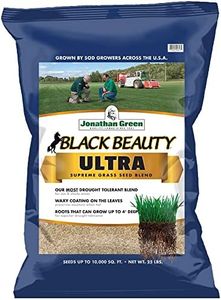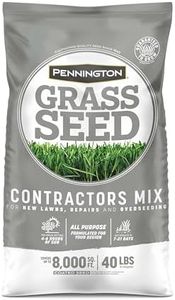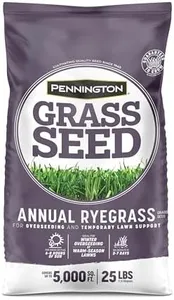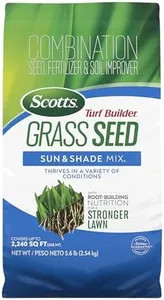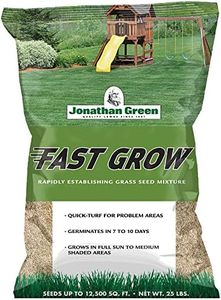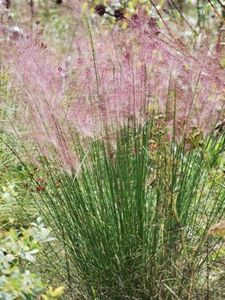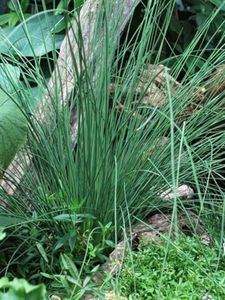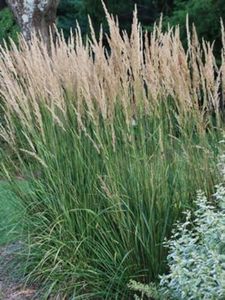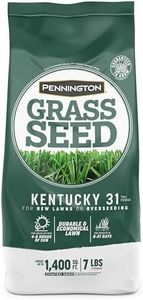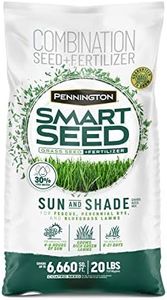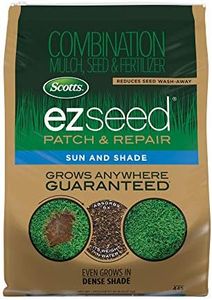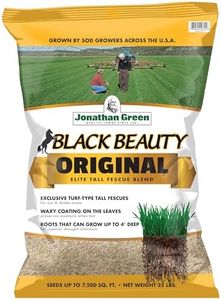10 Best Lawn Seeds 2025 in the United States
Our technology thoroughly searches through the online shopping world, reviewing hundreds of sites. We then process and analyze this information, updating in real-time to bring you the latest top-rated products. This way, you always get the best and most current options available.

Our Top Picks
Winner
Jonathan Green (10323) Black Beauty Ultra Grass Seed - Cool Season Lawn Seed (25 lb)
Most important from
5623 reviews
The Jonathan Green Black Beauty Ultra Grass Seed is a cool-season lawn seed mix that includes tall fescues, Kentucky bluegrass, and perennial ryegrass. It's designed to quickly establish new lawns and fill in bare spots, making it ideal for those looking to improve thin or damaged lawns. One of its major strengths is its ability to produce a healthy, dense, and dark-green turf, adding aesthetic value to any lawn.
Additionally, the seeds have roots that can grow up to 4 feet deep and a waxy leaf coating, which helps to retain moisture and limit evaporation, making it quite resilient under heavy traffic conditions. It requires regular watering and is compatible with clay soil, though it may not be suitable for sandy or highly acidic soils.
The best planting time is from mid-August to mid-October or mid-March to mid-May, which aligns with its growth rate of 7-14 days. The 25 lb bag covers up to 5,000 sq. ft. for new lawns and 10,000 sq. ft. for overseeding, offering good value for larger areas. The requirement for full sun to partial shade means it might not be ideal for heavily shaded areas. Additionally, while it can handle moderate traffic, very high foot traffic areas might still see wear and tear. This product would be most beneficial for homeowners looking to rejuvenate their cool-season lawns with a hardy, visually appealing grass mix.
Most important from
5623 reviews
Pennington Contractors Grass Seed Mix Northern Mix 40 lb
Most important from
1350 reviews
The Pennington Contractors Grass Seed Mix Northern Mix is designed especially for lawns in the Northern US, making it a good choice if you live in that region. It works best in areas that get about 4 to 6 hours of sunlight daily, so it's suited for spots with moderate sun exposure. This seed mix is versatile enough for new lawns, overseeding, or repairing patches, offering quick and dense grass growth within 1 to 3 weeks, which is faster than many other mixes.
It covers a large area—up to 8,000 square feet with one 40-pound bag—making it efficient for big spaces. The mix includes grass types that generally thrive in cooler climates and different soil types common in the north, though it’s best to ensure your soil is properly prepared for optimal results. Regarding maintenance, this product is considered all-purpose, suggesting it doesn’t require specialized care but will still benefit from regular watering and mowing.
This seed mix should handle normal foot traffic reasonably well, although it might not be the best choice for heavily used areas like sports fields. If you need a reliable and fast-growing grass seed mix for a northern lawn with moderate sun, this product fits well. For lawns with very little sun or requiring seed mixes suited to heavy foot traffic or specialized soil conditions, other options may be more appropriate.
Most important from
1350 reviews
Pennington Annual Ryegrass Retail Bag to Overseed Warm Season Grasses, 25 lb
Most important from
720 reviews
The Pennington Annual Ryegrass is a solid choice for homeowners looking to overseed warm-season grasses like Bermuda and Zoysia during cooler months. This seed thrives best in areas that get about 6 to 8 hours of sunlight daily, making it suitable for lawns that receive full to partial sun. It establishes quickly, with visible green growth in just 3 to 7 days, which is great if you want fast results. This annual ryegrass is disease-resistant and holds up well under foot traffic, so it can handle moderate lawn use without easily wearing out.
It works well as a temporary green cover in northern lawns where warm-season grasses go dormant in winter, but it’s mainly meant for overseeding rather than permanent lawns. Moderate watering is needed to keep it healthy, and it adapts to a variety of soil types common in many US regions. On the downside, since it’s an annual, it won’t provide long-term coverage, so you’ll need to reseed each year if you want it to come back. Also, while it tolerates foot traffic, it might not be the best choice if your lawn sees heavy, constant use.
This 25 lb bag covers up to 5,000 square feet, making it a practical size for medium to large yards. To sum up, if you want a quick, green winter lawn that complements your warm-season grass, this ryegrass seed offers a dependable and easy-to-manage option.
Most important from
720 reviews
Buying Guide for the Best Lawn Seeds
Choosing the right lawn seeds is crucial for achieving a lush, green lawn that meets your specific needs. Whether you're looking to create a durable play area for kids, a beautiful garden centerpiece, or a low-maintenance yard, understanding the different types of lawn seeds and their characteristics will help you make an informed decision. Consider factors such as climate, soil type, sunlight exposure, and intended use to find the best fit for your lawn.FAQ
Most Popular Categories Right Now


